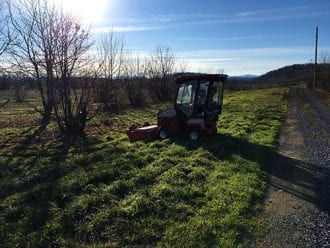The American Chestnut Foundation’s Meadowview Research Farms is facing a daunting task: the removal of several thousand trees from the Price, Duncan and Wagner farms. The decision to remove the trees was based on a variety of factors that include the overall health of the individual tree, progeny test history and the results of the data collected, as well as the need for more space for future plantings. Once the conclusion was made to move forward with “rogueing” the question was – how do we do it?

The Ventrac 4500Y is ready to get to work at Meadowview Research Farms, its new home.
Meadowview Research Farms has a staff of four full-time employees and one seasonal employee. With an abundance of routine farm and facility maintenance, as well as large, time sensitive projects such as site-prep, seed sowing, pollinating and harvest, staff capacity thresholds are tested throughout the year. After receiving tree removal quotes of $750,000 from
contractors, we looked at several pieces of equipment, known in the military as a ‘force multipliers,’ that would allow us to safely and efficiently remove trees with a small staff of workers in a reasonable amount of time. We reached out to one of our helpful partners, Emory & Henry College, whose grounds keeping department highly recommended their all-wheel drive Ventrac 4500, which due to the attachments offered, they use for just about everything on campus: snow removal, mowing steep hillsides and in tight spaces, brush clearing, stump grinding and light digging to name a few. We instantly recognized the value in such a versatile machine in our operation.
After an on-site demonstration of the machine with several attachments, we ultimately decided on the Ventrac 4500Y model. We prioritized the immediate need to increase efficiency and safety of our operation and chose an enclosed cab to protect the operator from tree limbs and inclement weather, a finish mower attachment for mowing grass between the closely-spaced rows of trees, a tough cut deck for cutting thick brambles and small trees, a bucket and grapple for carrying brush, and a stump grinder to aid in the complete removal of trees. The cost of these individual attachments and tractor was found to be far less than purchasing or renting similar stand-alone machines, and was astronomically less than hiring a contractor to do the work.
Thanks to a recent, generous grant from the Allegheny Foundation to support, in part, Meadowview Research Farms, TACF leaders approved the purchase of the Ventrac. This ‘force multiplier’ boosted Meadowview staff morale and we’re now moving forward to remove susceptible trees from our seed orchards to increase average level of disease resistance among the trees that remain.
